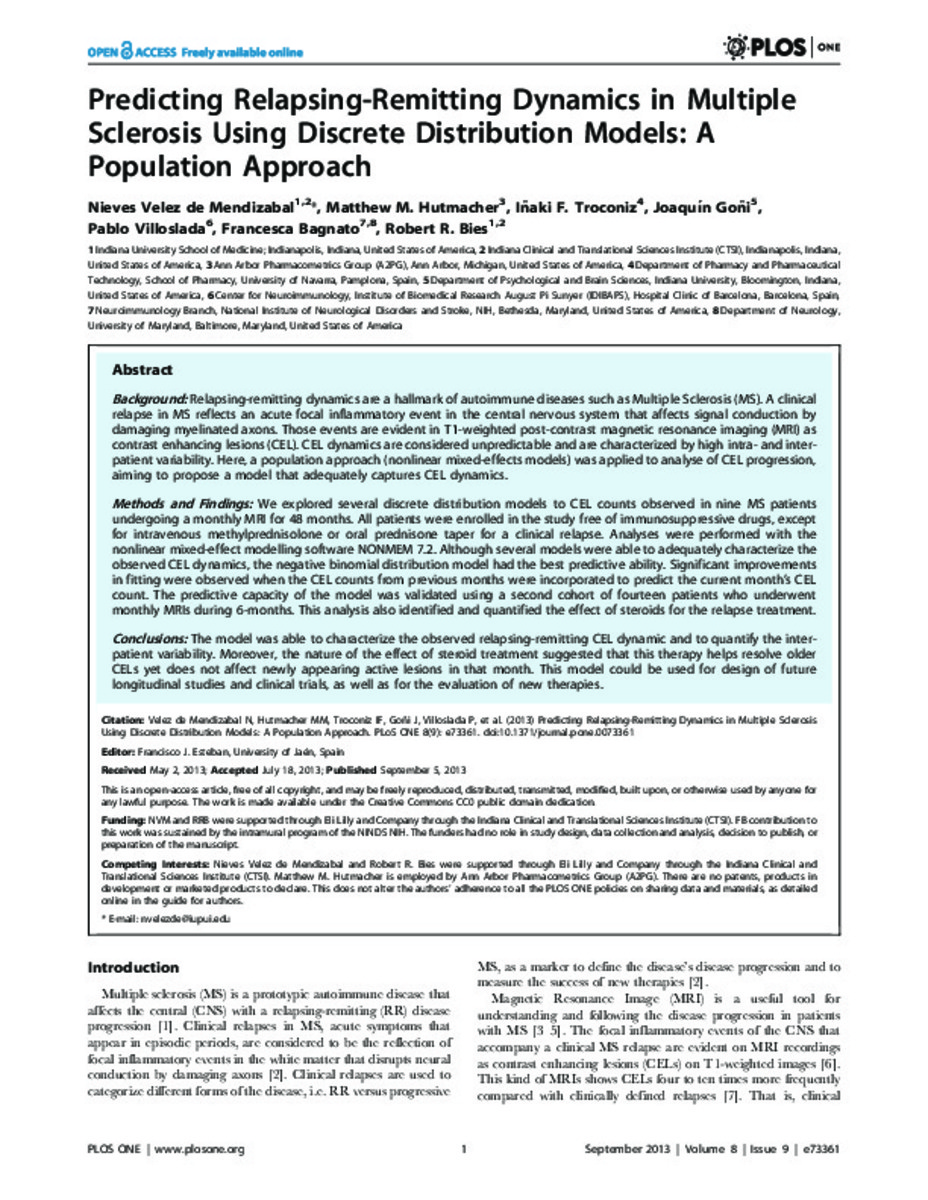Full metadata record
| DC Field | Value | Language |
|---|---|---|
| dc.creator | Velez, N. (Nieves) | - |
| dc.creator | Hutmacher, M.M. (Matthew M.) | - |
| dc.creator | Troconiz, I.F. (Iñaki F.) | - |
| dc.creator | Goñi, J. (Joaquín) | - |
| dc.creator | Villoslada, P. (Pablo) | - |
| dc.creator | Bagnato, F. (Francesca) | - |
| dc.creator | Bies, R.R. (Robert R.) | - |
| dc.date.accessioned | 2014-11-11T19:02:59Z | - |
| dc.date.available | 2014-11-11T19:02:59Z | - |
| dc.date.issued | 2013 | - |
| dc.identifier.citation | Velez de Mendizabal N, Hutmacher MM, Troconiz IF, Goni J, Villoslada P, Bagnato F, et al. Predicting relapsing-remitting dynamics in multiple sclerosis using discrete distribution models: a population approach. PloS one 2013 2013;8(9):e73361 | es_ES |
| dc.identifier.issn | 1932-6203 | - |
| dc.identifier.uri | https://hdl.handle.net/10171/37038 | - |
| dc.description.abstract | Background: Relapsing-remitting dynamics are a hallmark of autoimmune diseases such as Multiple Sclerosis (MS). A clinical relapse in MS reflects an acute focal inflammatory event in the central nervous system that affects signal conduction by damaging myelinated axons. Those events are evident in T1-weighted post-contrast magnetic resonance imaging (MRI) as contrast enhancing lesions (CEL). CEL dynamics are considered unpredictable and are characterized by high intra- and inter-patient variability. Here, a population approach (nonlinear mixed-effects models) was applied to analyse of CEL progression, aiming to propose a model that adequately captures CEL dynamics. Methods and Findings: We explored several discrete distribution models to CEL counts observed in nine MS patients undergoing a monthly MRI for 48 months. All patients were enrolled in the study free of immunosuppressive drugs, except for intravenous methylprednisolone or oral prednisone taper for a clinical relapse. Analyses were performed with the nonlinear mixed-effect modelling software NONMEM 7.2. Although several models were able to adequately characterize the observed CEL dynamics, the negative binomial distribution model had the best predictive ability. Significant improvements in fitting were observed when the CEL counts from previous months were incorporated to predict the current month's CEL count. The predictive capacity of the model was validated using a second cohort of fourteen patients who underwent monthly MRIs during 6-months. This analysis also identified and quantified the effect of steroids for the relapse treatment. Conclusions: The model was able to characterize the observed relapsing-remitting CEL dynamic and to quantify the inter-patient variability. Moreover, the nature of the effect of steroid treatment suggested that this therapy helps resolve older CELs yet does not affect newly appearing active lesions in that month. This model could be used for design of future longitudinal studies and clinical trials, as well as for the evaluation of new therapies. | es_ES |
| dc.language.iso | eng | es_ES |
| dc.publisher | Public Library of Science | es_ES |
| dc.rights | info:eu-repo/semantics/openAccess | es_ES |
| dc.subject | Multiple Sclerosis | es_ES |
| dc.subject | Steroid | es_ES |
| dc.subject | contrast enhancing lesions | es_ES |
| dc.subject | Materias Investigacion::Farmacia::Tecnología farmacéutica | es_ES |
| dc.title | Predicting relapsing-remitting dynamics in multiple sclerosis using discrete distribution models: a population approach | es_ES |
| dc.type | info:eu-repo/semantics/article | es_ES |
| dc.identifier.doi | http://dx.doi.org/10.1371/journal.pone.0073361 | es_ES |
Files in This Item:
Statistics and impact
Items in Dadun are protected by copyright, with all rights reserved, unless otherwise indicated.






